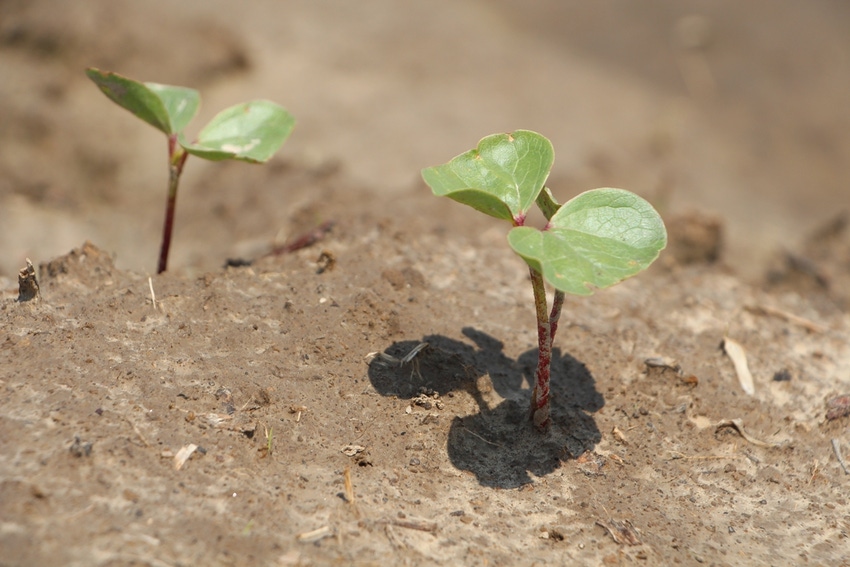
Despite it being the early spring season, nearly 200,000 acres of cotton have already emerged in deep South Texas, in some cases at eight-nodes and fully squaring. Periodic showers and late cool fronts at just the wrong time delayed planting schedules by about a week, but since mid-March South Texas producers have been working overtime to keep up.
It's also been a challenging start to the new season for some, especially those located near the Rio Grande River where insect activity is generally higher than across most of the Valley region. Texas AgriLife Extension IPM Specialist Danielle Sekula in Weslaco reports active pest activity in all three primary counties that make up the Valley region.
"The number of acres that have been treated for boll weevil from the start of the 2018 year to date has been about 5,204 acres," she said. "Some fields in the early cotelydon stage were sprayed for thrips while most fields are past that stage. We are slowly seeing cotton aphids increasing in fields across the Valley."
Sekula says there have also been a number of active predators in many fields and warns growers to scout for cotton aphids and spray at threshold numbers.
Also, red spider mites have been reported in the Mid-Valley area. She warns with continued dry weather conditions, growers need to watch carefully for excessive feeding that can cause stunted plant growth.
Fleahoppers are also very active across the entire region and there have been reports of blasted square damage as a result. She says farmers need to stay on top of potential fleahopper problems over the next four to five weeks, after which fleahopper pressure will begin to fade.
"Research shows that as many as 85 percent of total bolls harvested come from squares set during the period we are in now...[So] when scouting for fleahoppers (weekly is good), check 25 terminals in at least four locations of a field starting when first squares appear.
“If you notice 15 to 25 fleahoppers per 100 terminals with squares being lost, 15 percent the second week of squaring and 25 percent the third week of squaring, treatment is justified," Sekula noted
She says treatment is rarely needed after first bloom.
Troubling Crop Decisions
For nearly all South and Coastal Texas farmers, planting has either wrapped up of nearing conclusion, and it's too late to be concerned about whether to plant cotton or sorghum acres this year. That's not the case for High Plains growers who are still facing crop decisions and are troubled over trade war tariffs and China's decision to include sorghum on their list of U.S. agricultural products targeted in the tariff dispute.
China's inclusion of sorghum will affect the $1 billion flow of sorghum that has grown rapidly over the last five years. U.S. sorghum as a livestock-feed substitute for pricey domestic corn has been a rapidly growing trend in China since 2013, making the Asian nation U.S. sorghum producer’s largest foreign market.
The newly assessed Chinese tariff on U.S. sorghum amounts to nearly a 180 percent charge, a move U.S. Ag Secretary Sonny Perdue called "a political decision." Chinese trade officials said the tariffs were imposed to prevent U.S. "dumping" of grain, an allegation Perdue terms "ludicrous."
The issue, however, is already having a rippling effect across the Great Plains. Without the new tariffs, the potential for price increases of grain sorghum in the Asian markets are a reasonable possibility. But with the escalating trade barrier between Beijing and the Trump White House, there could quickly be a fall in global market prices for sorghum. While cotton remains another price-troubled commodity on the international markets, some strength has been noted in recent months.
One mid-west newspaper described crop decisions this year as not only troubling, but critical, reminding U.S. agriculture of the importance of trade and how lawmakers and the White House will shape the success or failure of agriculture trade for years to come. Farm groups, lobbyists and supporters have been warning Washington to tread lightly on the issue.
Threat of drought added concern
South Texas growers and most other Texas growers — except for those located in the eastern third of the state — are facing seemingly worse drought conditions in the early spring season. With the National Weather Service's long-term forecast calling for a good chance of worsening drought conditions at least into the summer months, the early half of the growing season appears to present a challenge for most farmers and ranchers across the Southwest.
Rain fall totals for the year are down in many locations across the Southwest region and in hardest hit areas lakes, rivers and reservoirs are beginning to show a decline in flows and levels. While no one is ready to call the year drought-riddled just yet, concerns about weather and irrigation availability are on the minds of most.
As a bonus worry for producers, the possibility of the success or failure of the adoption of a new and effective farm bill to address critical issues like safety net, price support, trade issues, and a host of other important issues for the industry presents another concern.
Despite the challenges of the year, farmers in South Texas say though they are always concerned about a host of issues every year, including the potential for drought, floods, falling prices, disasters and trade-related issues, the busy spring demands hard work and their full attention. They say with or without their worry, the other pieces of the puzzle will fall–one way or another.
About the Author(s)
You May Also Like




